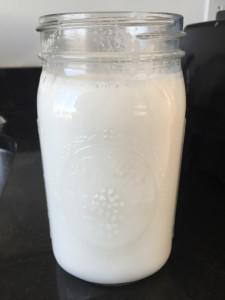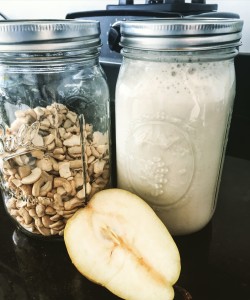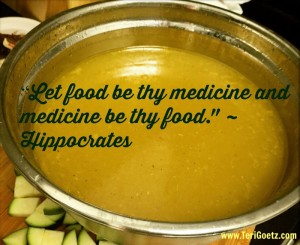(aka Saturated fat in coconut milk touted as good for you!)
Coconut milk is so good, it tastes like it should be bad for you! Instead, it’s one of the healthiest “milks” you can ingest.
Not to be confused with coconut water (rich in certain electrolytes and higher in sugar) which you derive from young coconuts, coconut milk is a nutrition powerhouse. It is called a milk because it is used the way we use dairy milk. Coconut “milk” comes from older coconut meat, which replaces the water of the younger coconut. What makes coconut milk so nutritious is its healthy saturated fatty acids — but not the kind that raises your cholesterol — as well as a host of vitamins and minerals.
Not all saturated fat is created equal

The fat-free craze is way over and it’s time to wrap your brain around the fact that you have to eat healthy fats to stay healthy and trim! People who eat “healthy fats” tend to eat less and are more satiated. These fats also seem to speed up your metabolism, as well. Coconut milk is being touted as good for your immune system, skin, hair, and heart health, and weight loss. All of these benefits seem to be the real thing! New research indicates that not eating enough “healthy fat” is actually making us fatter!
I know it gets confusing — low-fat, low-sugar, vegetarian, eat-meat, don’t eat meat — we’ve been told to do all of these things. All I can say is I follow the research. And research today is pointing to the fact that we’ve been eating low-fat for years and we are fatter and sicker than we’ve ever been. We are a population that has a sky-rocketing obesity rate (for adults and kids) and are on the road to 50% of us having diabetes by 2050.
Mark Hyman, MD points out in his latest book, Eat Fat, Get Thin:
In 1960, 1 out of 100 people in America had type 2 diabetes; today that ratio has changed to 1 out of 10 people, a tenfold increase. Since the 1980s, rates of type 2 diabetes have gone up 700 percent. In 1960 only 1 in 7 Americans was obese; now it is 1 in 3, and it is projected that 1 out of every 2 Americans will be obese by the year 2050. In 1980, there were almost no cases of type 2 diabetes in children. By the year 2000, nearly 1 in 10 kids was pre-diabetic or had full-blown type 2 diabetes. By 2008, nearly 1 out of every 4 teenagers was pre-diabetic or had type 2 diabetes.
Let’s look at the fat and benefits of Coconut Milk:
Coconut milk contains lauric acid, antimicrobial lipids, and capric acid, which have antibacterial, antifungal and antiviral properties. Lauric acid is a medium chain saturated fatty acid (MCFA) known to help the elasticity of blood vessels. MCFAs are metabolized pretty quickly by the liver, and unlike other saturated fats, it’s believed that they’re not stored in the body as fat and instead used as energy (not clogging arteries!). Lauric acid (also found in breast milk) is converted into monolaurin, which is an anti-viral and antibacterial substance that destroys a large variety of disease-causing organisms. Monolaurin has also been shown to promote both brain development and bone health. A milk that has that kind of good fat, as well as being anti-viral and antibacterial, has my vote!
Other benefits of Coconut milk
This yummy beverage is high in anti-oxidants (which go after bad free-radicals which cause diseases like Alzheimer’s, heart problems and cancer). It contains C, E (improves immune system) and several B vitamins (increases cellular energy) as well as magnesium (important for many cell processes, helps stabilize blood sugar and, along with the calcium found in coconut milk, soothes nerves and helps stabilize blood pressure), phosphorus (good for bones and teeth), iron (good for red blood cells and transporting oxygen throughout the body), selenium (works as an anti-oxidant and relieves joint pain associated with free-radicals) and potassium (good for promoting healthy organ tissues in the body like brain, kidney and heart).
Coconut milk has been used to promote digestion and seems to have a positive impact on stomach ulcers and acid reflux.
Skin and Hair
Containing vitamin E and fats, it is helpful for shiny healthy hair and glowing supple skin. It helps decrease hair loss while promoting hair growth and nourishing the hair. Some use coconut milk to cleanse the skin and help remove dead skin cells, leaving behind a well-hydrated, smooth appearance.
So, I hope I’ve convinced you to eat more healthy fat, and why coconut milk is a great alternative to cow’s milk!
Remember, here’s the great recipe for coconut (and cashew nut) milk again.
 Coconut and nut milks may be healthier alternatives to cow’s milk for many people, especially those following a paleo or elimination diet. For most adults, cutting down or cutting out dairy is a great idea. From a Chinese medicine perspective, dairy is basically phlegm! And, if you are like most Americans, your diet is already full of mucus producing, inflammatory foods.
Coconut and nut milks may be healthier alternatives to cow’s milk for many people, especially those following a paleo or elimination diet. For most adults, cutting down or cutting out dairy is a great idea. From a Chinese medicine perspective, dairy is basically phlegm! And, if you are like most Americans, your diet is already full of mucus producing, inflammatory foods. Bone Broth: the Why
Bone Broth: the Why
